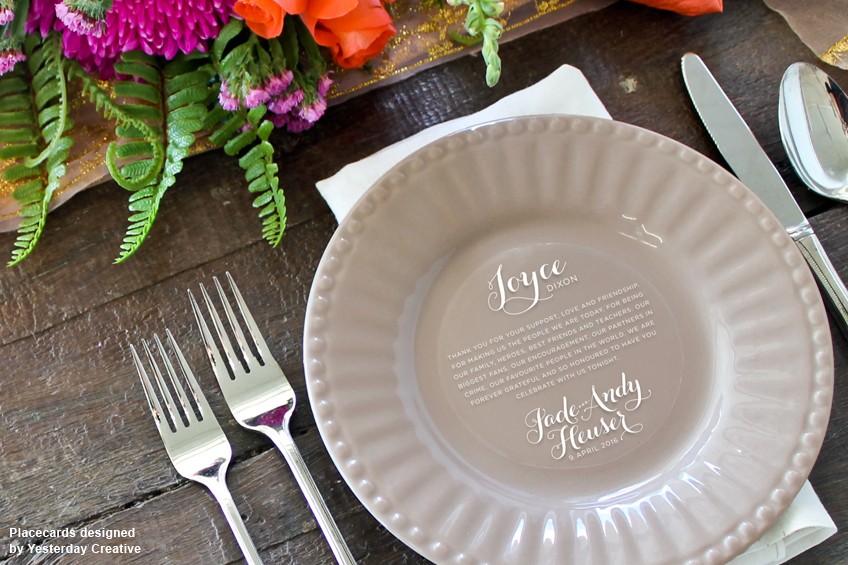When it comes to wedding stationery, there is more than the invitation to consider. The number of guests you have at your wedding affects everything you do. Looking beyond stationery, your guest list will determine the venue size, catering cost, how many wedding favours you need to make, how many chairs and napkins you may need to hire. Then there are place cards, menus, thank you cards, postage and whatever else may be on your dream stationery wish list.
The little things start to add up quite quickly so be realistic about numbers and create your guest list now to avoid stress later on!
Creating your guest list can seem like a bit of an overwhelming task to start, sounds daunting we know, but our team at Yesterday Creative are always here to offer advice with your wedding planning. We have prepared some useful tips to get you on your way with planning the guest list and to help you keep control of numbers.
1. Start with a spreadsheet
Using a spreadsheet such as Microsoft Excel or Google sheets allows you to keeping track of guests and wedding expenses with ease. Yep, we know, sounds boring right! But if you use Google sheets the great thing is that you can invite your finance and each set of parents in to collaborate on the list and add their guests in their own sheet. Use the one template for everyone to keep the list formatting consistent. Review each guest list once they are completed, make any changes, additions or deletions, and then combine your sheet with your partners and parents sheets into one final guest list. You can use this sheet to check off each guest as they rsvp, collect addresses and make notes on dietary requirements. Send the list to your wedding planner or venue and easily keep track of numbers for catering and to your wedding stationery supplier for addressing and personalisation of the wedding invitations.
Use a spreadsheet so that you can simply send a completed guest list to us to create a Data Merge of guest addresses for envelopes or digitally overprint names to personalise the wedding invitations and place cards—saves you having to spend hours and hours having to hand address your envelopes and trying to perfect your handwriting (resulting in nothing but writers cramp!) and reduces the need to use unsightly white adhesive mailing labels from Officeworks!
2. You and your finance should create your own lists
Both you and your partner should create a list that will be combined into one at the end. Take notes on the number of people associated with each name, including spouses, significant others, and children (if you are considering including the little ones in your day).
When it comes to invitations, don’t forget to group your guests into couples or families. Brides often come into our studio and tell us that they require 130 invitations, but we know that the average wedding reception caters for 120-150 guests. To confirm the cost for wedding stationery our first question is usually along the lines of “is that how many invitations you need, or how many guests you have?”… The answer is usually always the latter, with the couple having forgotten to pair up their guests on the list and really only requiring 75 invitations.
3. Allocate space and negotiate the guest list fairly with parents
If your parents are contributing largely to the wedding and they wish to invite their friends, an appropriate suggestion may be to discuss on how the guest list should be divided up. Every wedding is different however allocate places on the guest list fairly — e.g., designate one third to the parents of the bride, one third to the parents of the groom, one third for the bride and groom themselves. If one family is much larger than the other this of course may need to be taken into account so negotiate early with each set of your parents on a specific number of invitations they may send and have your parents prepare a list to avoid last-minute invitation requests. However if you have never met or spoken to a friend or distant family member that your parents wish to invite you may choose to negotiate on removing them from the guest list as a way of capping numbers.
4. Create an ‘A’ and ‘B’ list
Nobody wants to leave anyone out of their wedding, but if your guest list is larger than your venue’s capacity you’ll be holding your breath every time you receive an RSVP. In response to this many of our clients create two lists. The first, List A, with the family and friends that you really can’t enjoy your day without and perhaps the interstate or overseas family along with the guests that you really must invite but secretly don’t mind if they regretfully decline the invitation; then List B for those guests that may be work colleagues, extra friends that you would like to invite but who you don’t keep in contact with regularly, or the your distant second cousin’s new girlfriend who you have never met.
Mail your invitations early to List A first and if some guests are unable to make it or you end up having more space than you thought you would, you can send invitations in order of importance to your selected guests from List B. However be careful, this may not be the best way to reduce numbers, especially if the mailing is not timed well, or if the list gets mixed up, or if Cousin A has been talking to Cousin B who has not received an invitation yet.
USEFUL TIP:
Create an A list and a B List. Send your A-list invites three months before, which will give you time to send invites to your B-list six to eight weeks before your wedding. Don’t forget to print a second set of reply cards with a later RSVP date (sending RSVPs with a date that has passed is a dead giveaway that the recipients were on your B-list).
5. Set rules as to who can bring a guest.
The general rule is that you should invite significant others who live together or who have been a known couple of for a long time. There is no obligation to “and guest” anybody you know is single, if somebody asks to bring a friend along, don’t feel obliged to say yes. If you work in a large office perhaps you may allocate a table to work colleagues but if you have never met their husband or partner don’t feel terrible if you decide not to invite them.
6. Include seat allocations or write names on the RSVP Cards
Writing names or specifying that there is 1 or 2 seats reserved for a guest at the wedding on the Reply Card, is a clear way to avoid last minute add on’s and the awkward question of ‘Can I bring a guest?’. Sounds terrible, but there is always someone who has a partner you may not wish to invite, or a single guest who wants to bring a date. Do this, and there’s almost no way anyone can force an invite on you.
If you still receive a request to bring a date, just politely call and tell them: “Of course, we’d love to have everyone, but budget and space means it’s just not possible.”
7. Only invite Current Friends
If you haven’t talked to someone in more than a year, or don’t stay in current contact via phone or email regularly, this may be a reason to put them on the B List or leave them off altogether. Being Facebook friends does not qualify you for a wedding invitation.
8. Adults Only or Child-friendy?
Having an adult only wedding is a quick way to reduce numbers. Most of our clients do not invite children to their wedding unless they are a part of the wedding party (ring bearer or flower girl), however the topic of children at a wedding is often an issue within family so set clear rules around who may bring children or cut off the guest list at 18yrs of age.
You may choose to invite children to the ceremony then organise a baby sitter during the reception. The newborn child of a family member or friend may be invited, but if older children are invited, remember you will still have to pay for seating and a meal. Also, consider whether your friends will keep an eye on their little darlings all evening or whether they’re more likely to let them tear around the wedding venue unsupervised. It’s OK to have an adult’s only wedding.
9. Co-workers
When inviting people from work consider whether it’s an obligation or a good friend. Guest lists can often grow by couples who don’t want to leave out any of their co-workers. If you allocate a table to your work buddies perhaps don’t invite “plus one’s” if you don’t know their partners too well. This is a quick way to help keep the numbers down.
10. Would you be offended if you weren’t invited to their wedding?
Because you were invited to a friend or colleagues wedding at some point in the past 5 years, should not automatically put that person on your guest list. The only invitations you may feel obligated to send would be to a couple whose wedding you attended within the past year. But remember you can’t cut someone from your wedding and then expected to be invited to theirs.
Wedding Planner Emily Bedard offers some great advice here:
“Don’t return the favour. Cut any guests who are on your list simply because they invited you to their wedding. You need to remember everyone’s circumstances are different. You can’t assume the same criteria.”
All experts agree, when it comes to weddings, you need to be selective, even harsh. If you’re on any kind of tighter budget, then things need to be trimmed even further.
Useful Resources:
Use The Knot Budget Calculator to play around with the numbers and see how much you can save or spend by subtracting or adding from your guest list.
Glamour.com – How to Cut Your Wedding Guest List (Without Hurting Too Many People’s Feelings) by Meredith Bodgas
i-do.com – Getting To Grips With The Guest List

